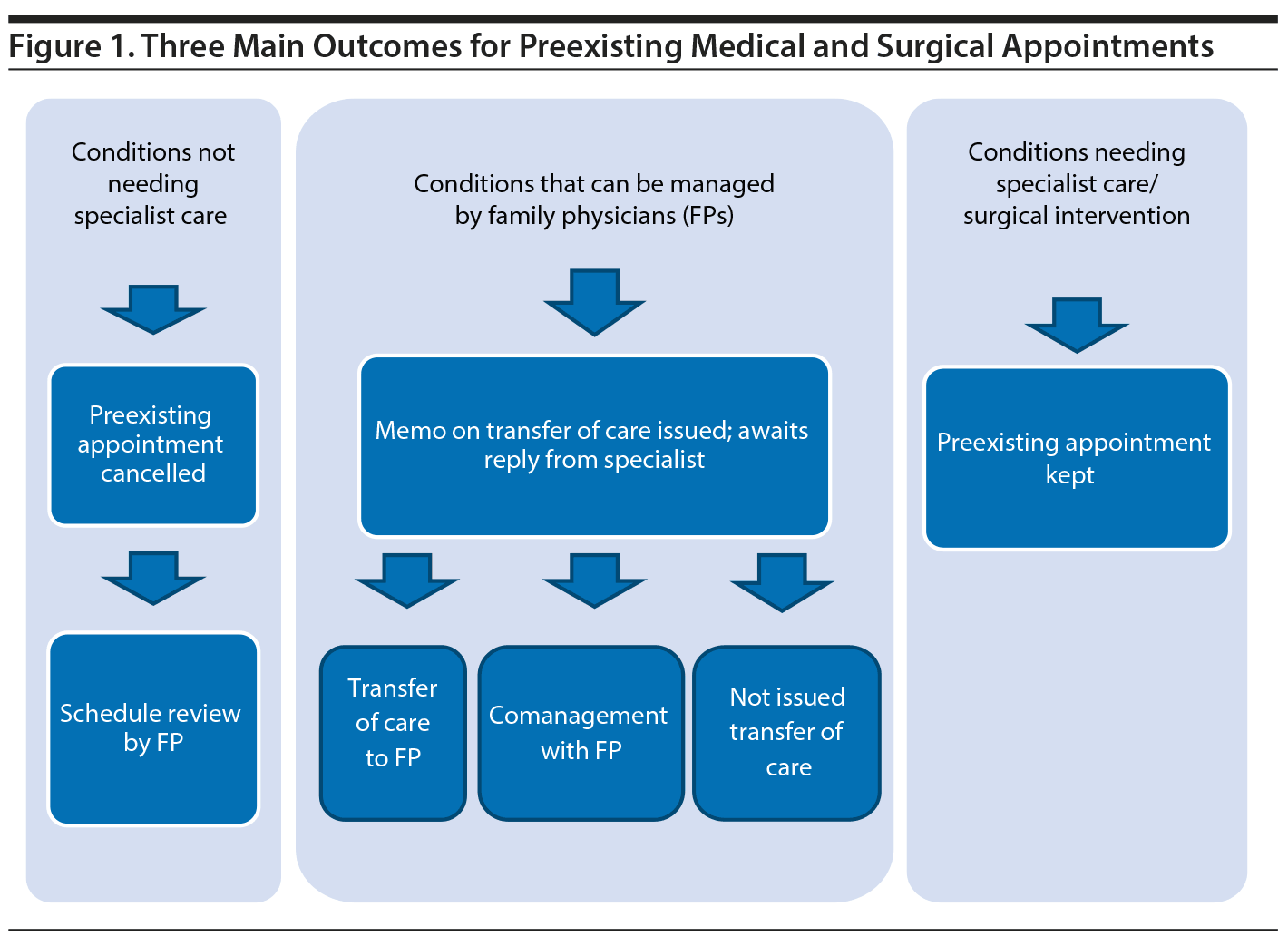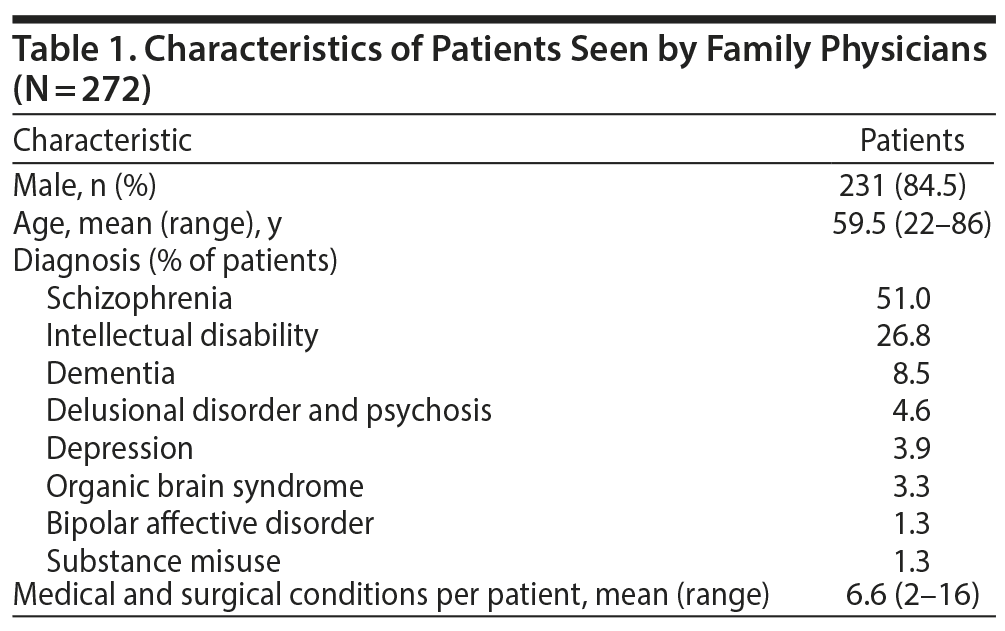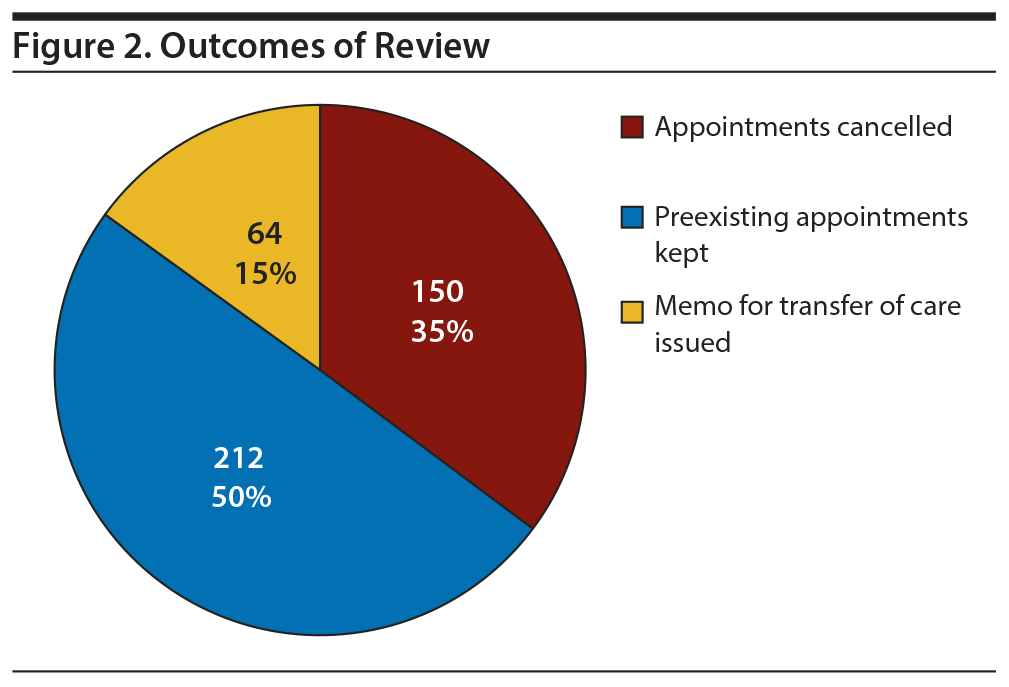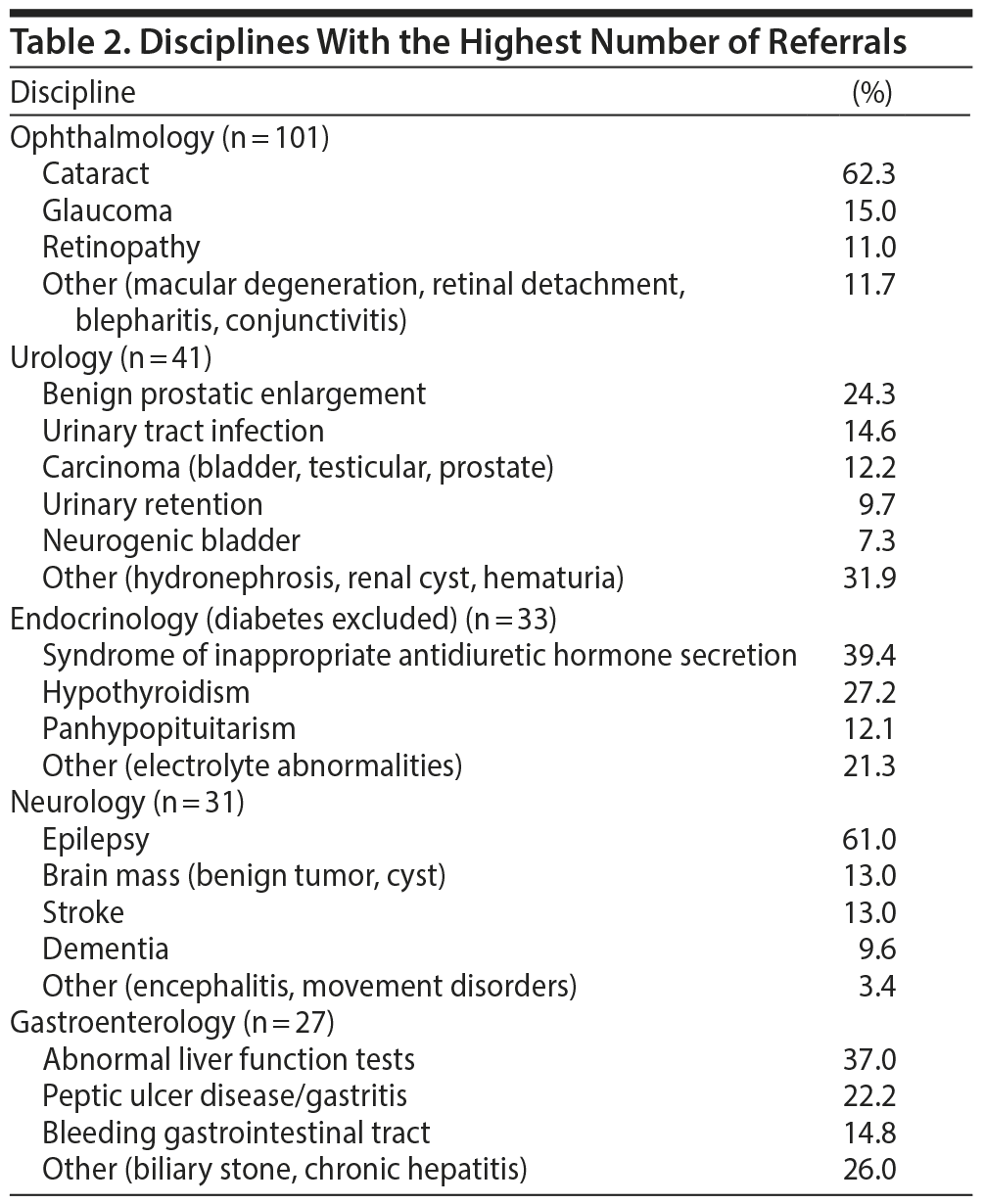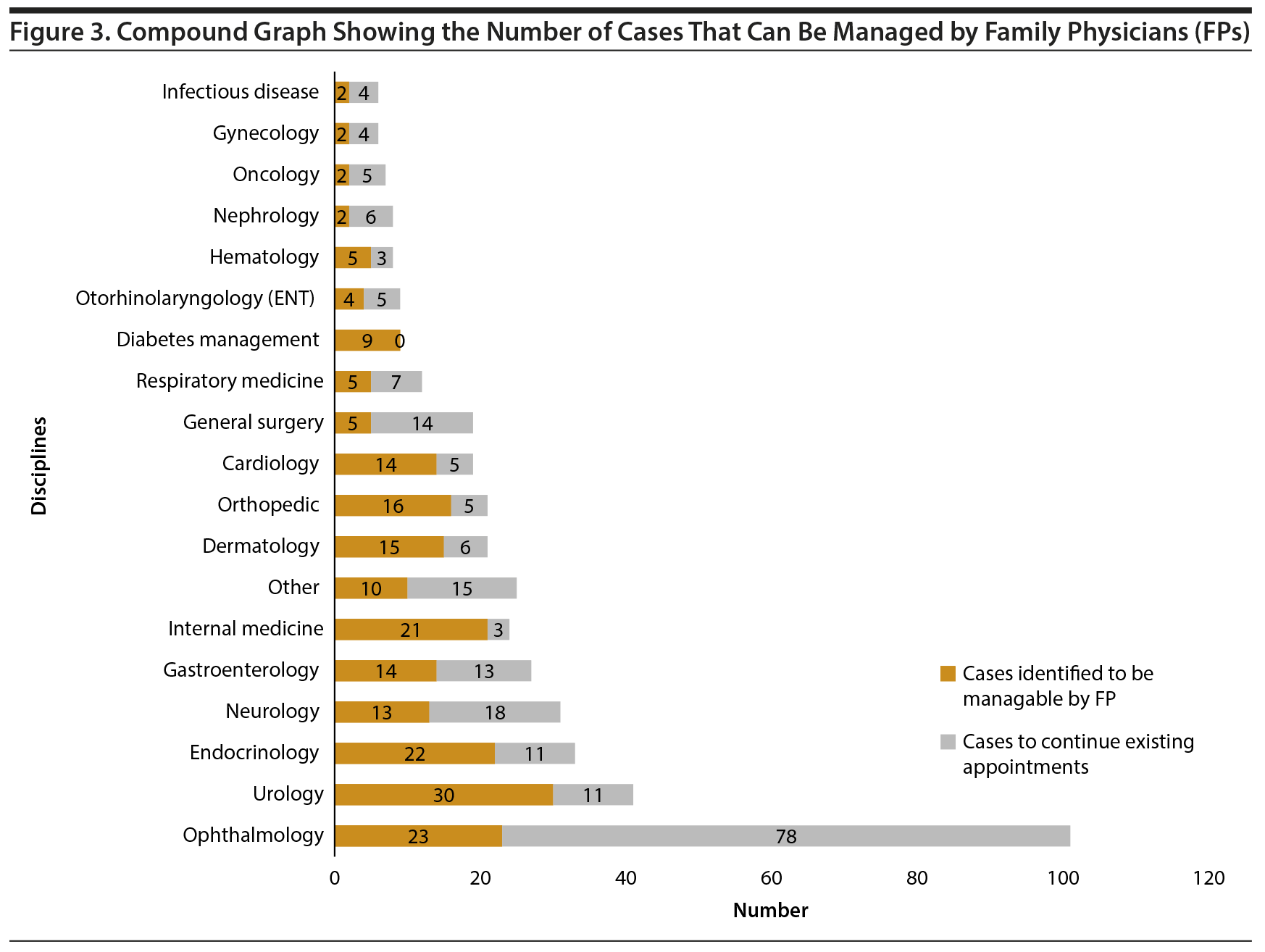Background:The Institute of Mental Health (IMH), the leading tertiary psychiatric hospital in Singapore, has managed patients’ psychiatric issues for decades. However, these patients’ existing medical conditions often require care in subspeciality outpatient clinics of restructured hospitals. Given the need to reduce follow-up appointments in subspeciality outpatient clinics for conditions that can be managed by family physicians, a novel family medicine-psychiatry collaborative initiative between Sengkang General Hospital and IMH was implemented to address this issue.
Methods: Data were retrospectively collected on patients with upcoming appointments who were seen by family physicians at IMH from January 2 to May 14, 2017. Patients with upcoming appointments in the subspeciality outpatient clinics were scheduled for review by family physicians. Continuous data were summarized as median (range) and count (percentage).
Results: At 4.5 months, 272 patients with 426 preexisting specialty appointments had been seen by family physicians. Of the specialty appointments, 150 (35.2%) were cancelled, as the conditions could be managed by family physicians. In 64 (15.0%) cases, a memo requesting transfer of care was given to the subspecialty consultant to ensure a consensus regarding the patient’s management.
Conclusions: Family physicians embedded in mental health institutions can reduce the need to transfer patients out of the hospital to receive care for nonpsychiatric conditions.
‘ ‹’ ‹
This work may not be copied, distributed, displayed, published, reproduced, transmitted, modified, posted, sold, licensed, or used for commercial purposes. By downloading this file, you are agreeing to the publisher’s Terms & Conditions.
Reducing Follow-Up Appointments in a Mental Health Institute in Singapore:
Family Medicine-Psychiatry Collaboration
 ABSTRACT
ABSTRACT
Background: The Institute of Mental Health (IMH), the leading tertiary psychiatric hospital in Singapore, has managed patients’ psychiatric issues for decades. However, these patients’ existing medical conditions often require care in subspeciality outpatient clinics of restructured hospitals. Given the need to reduce follow-up appointments in subspeciality outpatient clinics for conditions that can be managed by family physicians, a novel family medicine-psychiatry collaborative initiative between Sengkang General Hospital and IMH was implemented to address this issue.
Methods: Data were retrospectively collected on patients with upcoming appointments who were seen by family physicians at IMH from January 2 to May 14, 2017. Patients with upcoming appointments in the subspeciality outpatient clinics were scheduled for review by family physicians. Continuous data were summarized as median (range) and count (percentage).
Results: At 4.5 months, 272 patients with 426 preexisting specialty appointments had been seen by family physicians. Of the specialty appointments, 150 (35.2%) were cancelled, as the conditions could be managed by family physicians. In 64 (15.0%) cases, a memo requesting transfer of care was given to the subspecialty consultant to ensure a consensus regarding the patient’s management.
Conclusions: Family physicians embedded in mental health institutions can reduce the need to transfer patients out of the hospital to receive care for nonpsychiatric conditions.
Prim Care Companion CNS Disord 2019;21(3):18m02405
To cite: Ong CY, Soh LL, Low SG, et al. Reducing follow-up appointments in a mental health institute in Singapore: family medicine-psychiatry collaboration. Prim Care Companion CNS Disord. 2019;21(3):18m02405.
To share: https://doi.org/10.4088/PCC.18m02405
© Copyright 2019 Physicians Postgraduate Press, Inc.
aDepartment of Family Medicine, Sengkang General Hospital, Singapore
bPost-Acute and Continuing Care, Singhealth Community Hospitals, Singapore
cDepartment of Mood and Anxiety, Institute of Mental Health, Singapore
dMedical Care Services, Institute of Mental Health, Singapore
*Corresponding author: Chong Yau Ong, FCFP(S), Department of Family Medicine, Sengkang GeneralHospital, 110 Sengkang East Way, Singapore 544886([email protected]).
Recently, there is increased awareness of the benefits of and need for collaboration between psychiatrists and family physicians (FPs). This collaboration is aimed at improving continuity of care and providing holistic and comprehensive care to patients.1 Because of the prevailing degree of mental disorders in the community, most collaborations between psychiatrists or mental health professionals and FPs have been conducted in primary care settings for ease of patient treatment.2 Among the achievements of such collaborations were improved pickup rate of psychiatric disorders and early management, improved acceptance of treatment, and increased patient satisfaction for those who refused referral to a psychiatric clinic.3-5
However, the collaboration can be implemented in an inpatient setting. A collaborative model in which FPs participated in the care of psychiatric inpatients resulted in decreases in the patients’ length of stay and rate of specialist referrals and improvements in staff satisfaction.6 Evaluation of models integrating FPs into psychiatric settings has shown an improvement in quality and medical outcomes, health maintenance, and care coordination.7
A hybrid model in which patients were randomized to either an integrated team (medical care in psychiatry clinic) or routine care clinics showed that patients in integrated teams had greater compliance with preventive measures specified by the US Preventive Services Task Force.8,9 These improved services included blood pressure monitoring, lipid and diabetes screening, influenza vaccination, smoking cessation, and education counseling on exercise.
With increasing subspecialization, patients receive more medical, surgical, and follow-up appointments for each specific condition or illness.10 Health care delivered by multiple subspecialities without coordination may result in costly duplication of tests and rising health care costs.11
In Singapore, there was a need to reduce follow-up appointments in subspeciality outpatient clinics in restructured hospitals for conditions that could be managed by FPs. Inpatients at the Institute of Mental Health (IMH) in Singapore had their psychiatric conditions managed under the dedicated care of a psychiatrist and well-trained nurses and therapists. However, their existing medical and surgical issues required referral to other general hospitals, as there were no inpatient generalist physicians at IMH to manage the myriad of medical conditions. This need for external referral led to a novel initiative encompassing family medicine-psychiatry interdisciplinary collaboration to help address these issues.
METHODS
Data were collected retrospectively on patients with existing specialty outpatient clinic appointments who were seen by FPs within IMH from January 2-May 14, 2017. No ethics approval was required per discussion with the IMH Ethics Committee.
Setting and Participants
IMH is the only tertiary psychiatric hospital in Singapore and houses more than 1,850 inpatients. A ground-up collaboration initiative between Sengkang General Hospital, a new regional general hospital in the Northeast of Singapore, and IMH was started in January 2017. Both parties agreed that most of the medical and surgical problems could be managed by well-trained FPs with at least a master’s degree in family medicine awarded by the National University of Singapore. These FPs have managed inpatient general medicine and community medicine patients.

- In the inpatient psychiatry setting, trained family physicians can manage the majority of patients’ chronic and simple acute medical and surgical conditions.
- An integrated approach to care reduces mobilization of patients and nursing staff to external specialty outpatient clinics.
During the 4.5-month study period, there were a total of 1,154 patients in 23 long-stay wards. These wards house patients whose length of stay exceeded 350 days and for whom all discharge options have been explored and failed. Of the 1,154 patients, 272 were identified by the lead ward nurses to have existing specialty outpatient clinic appointments. The specialty outpatient clinic appointments were scheduled before the study started and spanned from January 2-November 30, 2017.
Collaborative Model
Long-stay inpatients with an upcoming appointment in a specialty outpatient clinic were identified and scheduled for in-house, ward-to-ward visitation by the FPs within IMH. During the study period, all 272 patients received visits from the FPs (C.Y.O., L.L.S., S.G.L., F.F.V.).
Two afternoon sessions (Tuesday and Thursday) a week were dedicated for these appointments, whereby a pair of FPs visited the scheduled wards to provide services to the identified patients. Each session lasted about 2 to 3 hours depending on the number of participants in the particular ward and the complexity of the conditions to be addressed.
The visits were performed by the same 4 FPs (3 men and one woman). The physicians ranged in age from 34 to 49 years old, and length of years in practice ranged from 9 to 24 years. None of the FPs had prior contact with IMH. Consistency of recommendations was ensured, as all 4 FPs were trained under the same local master’s program in family medicine, and several criteria on whether a patient can be managed in-house rather than off-site were predefined before the first visit. The recommendations (Figure 1) were shared decisions between the 2 FPs and the patient (if he or she had the decision-making capacity). In more difficult cases, the other pair of FPs was called to be involved in the recommendation. We found high agreement between the 4 FPs with regard to the recommendations.
During the ward review, the inpatients with preexisting appointments and follow-up visits scheduled in other hospitals were seen by the FPs. Electronic and paper medical notes were reviewed; indications for the visits and date and specialty of upcoming appointments were noted. A brief history was taken from the patients, and for those who were uncommunicative or unable to provide reliable history, collaborative histories were also obtained from the nurses managing the patients in the wards. Patients were examined, and their investigations (blood tests and radiologic results) were reviewed. Reply memos from subspecialists were examined as well. A holistic overview was made of the patient’s biopsychosocial issues. This overview was based on the Stott and Davis care model.12,13 Patients’ concerns and expectations were addressed,14 and the FP also provided patient education. Thereafter, the FP decided on the outcomes for each preexisting appointment.
There were 3 possible outcomes: (1) continue with the preexisting appointment, (2) give a memo to the subspecialty doctors requesting transfer of care or comanagement with the FP, or (3) cancel the preexisting appointment and manage the patient in-house (Figure 1). Preexisting appointments were cancelled for patients with conditions that could be managed confidently and safely by FPs without the need for referral to a specialty outpatient clinic. Some of these patients were scheduled to be seen by FPs within IMH. For patients with conditions that required consultations with subspecialists as to whether they could be transferred to our care at IMH with consensus on the future management plan or comanaged with reduced visits (perhaps once yearly) to the specialty outpatient clinic, a memo for transfer of care was issued for the patient to take to their next subspecialty visit. As for conditions that needed monitoring by the subspecialty consultant or that were being planned for surgical interventions, the appointment with the subspeciality consultant was kept.
The second round of ward-by-ward patient consultations was provided for newly admitted patients and preexisting patients seen 3 months previously who required follow-up care from the FPs. Ward doctors could contact the FPs during office hours with any questions about their patients.
Data Analysis
Data were descriptive in nature and summarized in the count (percentage). No inferential statistics were applied.
RESULTS
Characteristics of Patients
A total of 272 patients were seen in the first round of ward review from January 2 to May 14, 2017. Characteristics of the patients seen are summarized in Table 1. Most of the patients were male (84.5%) with a mean age of 59.5 years (median of 58 years). The majority of the patients had a primary diagnosis of schizophrenia (51.0%), followed by intellectual disability (26.8%). The patients had a mean of 6.6 significant medical and surgical conditions. Each patient had a mean of 1.6 preexisting appointments related to 1 or 2 of their medical or surgical conditions.
Collaboration Outcomes
After the first round of reviews at 23 long-stay wards, 426 preexisting appointments were assessed. Of those, 150 (35.2%) were able to be managed by FPs from Sengkang General Hospital at IMH. Sixty-four appointments (15.0%) could potentially be managed by FPs at IMH; however, for professional and safety reasons, a memo of transfer of care from the IMH FPs was issued to the subspecialty consultant indicating the intention of taking over care of the patient. The subspecialty consultant was given the option to transfer care, comanage care, or reject the transfer of care request. The memo allowed the specialists to comment on pertinent points regarding the safe transfer of care of the patient to a FP. The remainder of the 212 (49.8%) preexisting appointments was kept unchanged (Figure 2).
Disciplines and Conditions
Analysis by disciplines and specialties showed that most of the patients had preexisting appointments with specialists of the following departments: ophthalmology (101), urology (41), endocrinology (not including diabetes) (33), neurology (31), gastroenterology (27), internal medicine (24), dermatology and orthopedic (21 each), cardiology (19), and general surgery (19). Table 2 summarizes the top 5 disciplines with the highest number of referrals.
After review by FPs, we identified 23 ophthalmology cases that did not need follow-up with the ophthalmologists. These cases included resolved conjunctivitis, preseptal cellulitis, chalazion, and other benign acute eye conditions. However, the majority of the cases (78 [77.2%]) were chronic eye conditions such as cataracts, glaucoma, and retinopathy, which required continued follow-up with the ophthalmology department.
All 9 appointments for diabetes care were deemed manageable by FPs and were thus cancelled. Additionally, the FPs were also comfortable in managing two-thirds of the endocrine-related conditions such as thyroid disorders and syndrome of inappropriate antidiuretic hormone from psychotropic medications.
A substantial 91.3% of cases with follow-up appointments with internal medicine were noted to be manageable by FPs and did not require follow-up with the internal medicine specialists.
Previous fractures that had healed without limitation in function, osteoporosis, and osteoarthritis were identified among orthopedic conditions suitable to be managed by FPs. Urological conditions that were found manageable by the FPs included benign prostatic enlargement, uncomplicated renal cysts, cystitis, and uncomplicated urinary tract infections.
Only 5 of 19 preexisting appointments with general surgery were deemed safe to be followed up by FPs. A breakdown of cases that could be managed by FPs is shown in Figure 3.
DISCUSSION
Half (50.2%) of the existing appointments from various disciplines scheduled for the psychiatric inpatients could be managed by FPs at IMH. Two-thirds of these appointments were cancelled with no need for a transfer memo from the specialist, as they were within the scope of the FP’s knowledge.
This result supports findings of Behroozi et al6 wherein the rate of specialist referrals in the wards decreased after initiation of FP consultations. Newly diagnosed diabetes, endocrine disorders, cardiovascular disease, dermatologic disorders, gastrointestinal disorders, and respiratory illnesses were examples of the conditions managed by the FP.6,15
This result is also in keeping with a randomized controlled trial by Rubin and colleagues16 that compared usual care (routine in-house psychiatry team) to an intervention team (routine plus internal medicine physician). The results showed not only significant improvement in the coordination of care and resource use in the intervention group, but also improvement in needs assessments (review of systems, medication list review, family risk plan) and health maintenance (Pap screening and cancer screenings) in the intervention group with no significant escalation in cost.16
It is difficult to discontinue ophthalmology appointments for patients with conditions such as cataracts, glaucoma, glaucoma suspect, and retinopathy because visual impairment is associated with functional decline, falls, increased community services, and depression.17 Even in the absence of established eye pathology, it is recommended that the elderly have an eye examination at least once every 1 to 2 years so that many of the asymptomatic eye conditions may be detected early and treated promptly.17,18 Unavailability of radiologic investigations beyond x-ray limit the extent of conditions that can be managed at IMH. For surgical-related conditions, most patients would still need continuing visits with specialists for surgery and post-surgery follow-ups.
Broad-based knowledge in medical and surgical health care has allowed FPs to be well-rounded generalists.6,19 Conditions that can be managed by FPs do not warrant specialty outpatient appointments.15 Without established primary care programs, referrals or access to care through the emergency department can still be prevalent.20 This finding supports the previous work of Fisher and Roberts21 regarding the important role of FPs in long-stay wards.
Strengths, Limitations, and Future Plans
This article reports on the first interdisciplinary collaboration between a mental health institute and a department of family medicine in Singapore designed to reduce the number of patients transferred out of the hospital by making care of nonpsychiatric conditions available and accessible within the mental health institute itself. This model allows IMH inpatients to receive care for their chronic and simple acute medical conditions in-house without the need for transport to various restructured hospitals.
Patients with manageable medical and surgical conditions are seen in-house by the same team of FPs. Continuity of care is maintained, less disruption of interdisciplinary care arises, and facilitation of care coordination can take place if needed.
Despite the promising potential benefits, this model does have limitations. For inpatients in acute-stay wards, the benefits of continuity of care are limited, as they would only have 1 or 2 consultations with the FPs at IMH before they are discharged into the community.
This initiative was also limited by the small sample size in a highly specific group of the population (inpatients with chronic medical or surgical conditions scheduled for subspecialty follow-up). The applicability of this collaborative work to another setting such as nursing homes, intermediate and long-term care centers, community polyclinics, and acute medical wards needs further research.
Cost analysis was not conducted to accurately quantify the total expenditure (direct and indirect) saved from this exercise. A study examining cost-effectiveness could be conducted to ascertain the extended cost benefits and the sustainability of the model.
It has long been argued that psychiatrists are also doctors and should be managing patients’ general medical conditions.15 However, limitations such as time restraints and unfamiliarity with general practice after years of psychiatry specialization have proved to be daunting.22 Thus, there are plans to regularly provide general practice education and updates at IMH.23,24
Clinical Implications
In the inpatient psychiatry setting, trained FPs are able to manage the majority of patients’ chronic and simple acute medical and surgical conditions. Such management promotes a multidisciplinary approach to patient care.
It would be worthwhile to explore replication of this collaborative model in centers in which the need (patients with numerous follow-up appointments with various subspecialities), the setting (slower turnaround of inpatients), or the resources (availability of a small team of trained FPs who are able to work closely with a team of psychiatrists) are similar.
CONCLUSIONS
A team of FPs embedded in IMH reduced the need to transfer patients out of the hospital to receive care for nonpsychiatric conditions. This integrated approach reduces health care expenditures of patients and the hospital and allows specialists to have more slots available for patients who truly warrant subspeciality care. Moreover, patients receive continuity of care from a team of FPs who work closely with the psychiatrist to holistically manage the biopsychosocial aspects of patients without care fragmentation.
Submitted: October 20, 2018; accepted February 21, 2019.
Published online: May 30, 2019.
Potential conflicts of interest: None.
Funding/support: None.
Acknowledgments: The authors thank Jolina Chua and Ong Wei Ting from the Operations Department at IMH for providing the data and maintaining the records of patients with pre-existing appointments. They report no conflicts of interest related to the subject of this article.
REFERENCES
1. Haggerty JL, Reid RJ, Freeman GK, et al. Continuity of care: a multidisciplinary review. BMJ. 2003;327(7425):1219-1221. PubMed CrossRef
2. Kessler RC, Demler O, Frank RG, et al. Prevalence and treatment of mental disorders, 1990 to 2003. N Engl J Med. 2005;352(24):2515-2523. PubMed CrossRef
3. Brazeau CM, Rovi S, Yick C, et al. Collaboration between mental health professionals and family physicians: a survey of New Jersey family physicians. Prim Care Companion J Clin Psychiatry. 2005;7(1):12-14. PubMed CrossRef
4. Lucena RJ, Lesage A. Family physicians and psychiatrists: qualitative study of physicians’ views on collaboration. Can Fam Physician. 2002;48(5):923-929. PubMed
5. Craven MA, Bland R. Better practices in collaborative mental health care: an analysis of the evidence base. Can J Psychiatry. 2006;51(suppl 1):7S-72S. PubMed
6. Behroozi D, Mazowita G, Davis MD. Collaboration in caring for psychiatric inpatients: family physicians team up with psychiatrists and psychiatric nurses. Can Fam Physician. 2008;54(1):57. PubMed
7. Cerimele JM, Strain JJ. Integrating primary care services into psychiatric care settings: a review of the literature. Prim Care Companion J Clin Psychiatry. 2010;12(6):e1-e4. PubMed
8. Druss BG, Rohrbaugh RM, Levinson CM, et al. Integrated medical care for patients with serious psychiatric illness: a randomized trial. Arch Gen Psychiatry. 2001;58(9):861-868. PubMed CrossRef
9. US Preventive Services Task Force. Guide to Clinical Preventive Services: Report of the US Preventive Services Task Force. Philadelphia, PA: Lippincott Williams & Wilkins; 1996.
10. Mehrotra A, Forrest CB, Lin CY. Dropping the baton: specialty referrals in the United States. Milbank Q. 2011;89(1):39-68. PubMed CrossRef
11. Lee KH. The hospitalist movement-a complex adaptive response to fragmentation of care in hospitals. Ann Acad Med Singapore. 2008;37(2):145-150. PubMed
12. Stott NC, Davis RH. The exceptional potential in each primary care consultation. J R Coll Gen Pract. 1979;29(201):201-205. PubMed
13. Howie JG, Heaney D, Maxwell M. Quality, core values and the general practice consultation: issues of definition, measurement and delivery. Fam Pract. 2004;21(4):458-468. PubMed CrossRef
14. Levenstein JH, McCracken EC, McWhinney IR, et al. The patient-centred clinical method, 1: a model for the doctor-patient interaction in family medicine. Fam Pract. 1986;3(1):24-30. PubMed CrossRef
15. Welthagen E, Talbot S, Harrison O, et al. Providing a primary care service for psychiatric in-patients. Psychiatrist. 2004;28(5):167-170. CrossRef
16. Rubin AS, Littenberg B, Ross R, et al. Effects on processes and costs of care associated with the addition of an internist to an inpatient psychiatry team. Psychiatr Serv. 2005;56(4):463-467. PubMed CrossRef
17. Green C, Goodfellow J, Kubie J. Eye care in the elderly. Aust Fam Physician. 2014;43(7):447-450. PubMed
18. Thilagaratnam S, Ding YY, Au Eong KG, et al. Health Promotion Board-Ministry of Health Clinical Practice Guidelines: functional screening for older adults in the community. Singapore Med J. 2010;51(6):518-521. PubMed
19. Lindenauer PK, Rothberg MB, Pekow PS, et al. Outcomes of care by hospitalists, general internists, and family physicians. N Engl J Med. 2007;357(25):2589-2600. PubMed CrossRef
20. Crews C, Batal H, Elasy T, et al. Primary care for those with severe and persistent mental illness. West J Med. 1998;169(4):245-250. PubMed
21. Fisher N, Roberts J. Primary health care service for long-stay psychiatric in-patients. Psychiatrist. 1998;22(10):610-612.
22. Carney CP, Yates WR, Goerdt CJ, et al. Psychiatrists’ and internists’ knowledge and attitudes about delivery of clinical preventive medical services. Psychiatr Serv. 1998;49(12):1594-1600. PubMed CrossRef
23. Hodges B, Inch C, Silver I. Improving the psychiatric knowledge, skills, and attitudes of primary care physicians, 1950-2000: a review. Am J Psychiatry. 2001;158(10):1579-1586. PubMed CrossRef
24. Tinsley JA, Sutor B, Agerter DC. Educational links between psychiatry and family practice. Gen Hosp Psychiatry. 2000;22(2):63-65. PubMed CrossRef
Save
Cite
Advertisement
GAM ID: sidebar-top
